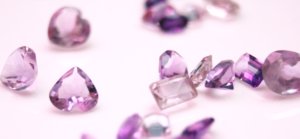 Gemstones are mined from the earth as rough crystals. Formed deep within the earth, heat and pressure cause minerals to crystallize in symmetrical patterns. Different minerals have different crystal structures depending on the individual arrangement of their atoms or molecules. The gemstones fashioned from these crystallized minerals will likewise have unique optical properties. It is the complex art and science of lapidary that brings out the inherent beauty of a gemstone. If you have ever seen a rough gemstone and admired its crystal structure, then you can no doubt understand the inspiration behind early artisans’ desire to amplify the natural beauty of gemstones.
Gemstones are mined from the earth as rough crystals. Formed deep within the earth, heat and pressure cause minerals to crystallize in symmetrical patterns. Different minerals have different crystal structures depending on the individual arrangement of their atoms or molecules. The gemstones fashioned from these crystallized minerals will likewise have unique optical properties. It is the complex art and science of lapidary that brings out the inherent beauty of a gemstone. If you have ever seen a rough gemstone and admired its crystal structure, then you can no doubt understand the inspiration behind early artisans’ desire to amplify the natural beauty of gemstones.
Facets of History
Gemstone carvings and the fashioning of beads date back thousands of years. It would appear that adornment has been a part of human culture since civilization began. The art of shaping, cutting, faceting, and polishing gemstones known as lapidary began in fourteenth century Europe and blossomed during the Renaissance. The first gemstone cutting machines were operated by foot. Early attempts at gem cutting followed the crystal structure of the gem in shapes such as the point cut, which was basically square. Advancement in maximizing the optical properties of gemstones gave rise to the briolette, a pear shaped faceted silhouette. Soon thereafter, the rose cut was introduced. Rose cuts are most often flat on the bottom with facets that culminate in a peak, with the silhouette taking many shapes. Double sided rose cuts may be seen as well. Versatile and a visual improvement on the briolette, rose cuts remained popular for over a hundred years. Today, we are seeing a resurgence of interest in the rose cut.
Brilliance Unearthed
As the desire to fully realize the reflection and refraction of light that gemstones are capable of, precise geometry was employed in the development of the brilliant cut. Gemstone faceting began in the 1300’s and it took several hundred more years for this art to evolve. Facets were added giving rise to first the table cut (square silhouette), single cut (octagonal silhouette), then the old mine cut (cushion silhouette), followed by old European cut (round silhouette). In the latter two, you can observe the origin of the modern brilliant cut, one of the most enduringly popular cuts for diamonds and frequently used in gemstones.
Modern Cuts
The evolution of technology and industrialization opened more and more possibilities within the world of lapidary. In today’s market, you see the culmination of hundreds of years of trial and error, distilling what was once a rudimentary art into a graceful harmony of applied science, advanced geometry, technical prowess, and precision skills. You will also see a wide range of silhouettes and faceting patterns such as:
- Faceted Cuts: Faceted gemstones include a wide range of silhouettes including round, cushion, oval, square, rectangular, pear, trillion, and marquis. The two major faceting patterns you are likely to see can be categorized as step cuts, where the faceting pattern runs in parallel lines and full cuts, characterized by octagonal, triangular, and kite shaped facets. The anatomy of a faceted cut includes:
- The table facet: the largest facet on the top of a gemstone
- The crown angle: the area in between the girdle and the tableThe girdle: the outer diameter or circumference of the gemstone
- The pavilion: the lower portion of the gemstone
- The culet or keel: the bottom point of the gemstone
- Cabochon Cuts: Domed or rounded tops with flat bottoms, cabochon cuts are used in precious and semi-precious gemstones alike. One of the earliest cutting styles, the cabochon remains a staple in gemstone cuts today.
- Mixed cuts: Mixed cuts show the artistic possibilities in lapidary skill. In a buff cut, a gem will be cut cabochon above the girdle with a faceted pavilion. A checkerboard cut may have step facets on the crown and kite facets on the pavilion.
- Branded cuts: Branded cuts are considered intellectual property of the companies that invented them and are often protected by trademarks. Most frequently applied to certain diamond cuts like the Lucida™ or the Hearts on Fire™, gem cutters are also getting on the branded bandwagon such as the Radial™ cut, introduced by Columbia Gem House.
- Fantasy cuts: As the name implies, fantasy (also known as fancy) cuts employ unusual silhouettes, concave facets, and mixed cuts to achieve spectacular and artistic results.
With the endless combinations of shapes, styles, and techniques, the likelihood of finding a gemstone cut that pleases you is all but assured – you can check out our comparison of the princess, round and radiant cuts as well. What do you look for in a gemstone cut? Are you drawn to a certain shape? Now that you know the history of gemstone cutting, can you imagine what the future will bring? Share your thoughts on gemstone cuts with us.
Want to learn more? Follow the path of a gemstone from Pebble to Perfection or read other posts from the Introduction to Gemstones series.
